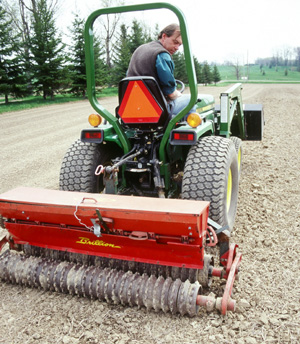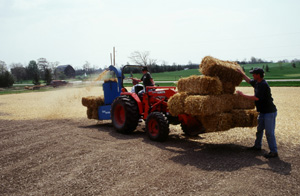My Cart: 0 item(s)
Seeding Large Meadows
For larger areas, it's not practical to broadcast the seed by hand although this can be done if you have the time. Instead, it's best to use a mechanical planter. Specific models that can successfully plant native grasses and flowers include the Tye drill, Truax drill, John Deere Rangeland drill, and properly outfitted Brillion seeders. Most wildflowers require a treatment that in horticultural terms is called "cold, moist stratification", in English this is called winter. Because of this we recommend sowing large meadows of an acre or more in the late fall. Knowing Your Equipment
The broadcast seeder we recommend is the Brillion double box agricultural model, typically used to seed alfalfa and grass mixtures, but equipped with native grass bristle brushes in the larger front box rather than the standard steel wire agitators. The Brillion seeder broadcasts seed rather than drilling it, creating a more natural effect (eg; no rows). The Brillion seeder requires a well-prepared seedbed with a loose surface soil in order to plant the seed properly. If you are using this seeder set the main box wide open to sow the native grasses and set the smaller flower seed box to 1. If a Brillion double box is not available you may use a Brillion single box seeder but the area will need to be seeded twice, once for the wildflowers and once again for the native grasses. No-till seeders commonly used for meadow plantings include the Truax drill, the Tye wildflower and native grass seeder, and John Deere seeders. It is important to know the capabilities and limitations of each seeder in order to select the one that will best suit your needs. The Tye, Truax, and John Deere seeders plant the seed in rows by opening slits in the soil into which the seed falls. Seed drills can open up the surface soil to seat the seed properly without working the soil just prior to planting. Hydroseeding is a planting process that uses a slurry of water, seed and paper mulch which is sprayed on the surface of the soil. Because Hydroseeding does not ensure firm seed-to-soil contact it is not recommended for wildflower meadow installations. TerraSeeding
TerraSeeding is a relatively new process that has been adopted by some landscaping companies across North America. Basically TerraSeeding is the calibrated incorporation of seed into composted soil during the application process. Simply put, it is seeding with soil. This method of sowing wildflower meadows has been quite successful, however as wildflower seed needs firm seed-to-soil contact it is important to roll sites sown by TerraSeeding. Mulching
After sowing the seeds, a light covering of clean, weed-free straw will help greatly to hold in moisture and increase germination. This is particularly helpful on dry, sandy soils and heavy, clay soils. The straw should just cover the soil surface, not bury it. We recommend chopping and blowing the straw over the area as straw laid using this method is less susceptible to wind; however, spreading the straw by hand can be quite effective as well. If you are seeding a steep slope, hold the straw in place by staking straw erosion control blankets that are made up of two layers of a photodegradable plastic with straw placed in between the layers. Erosion control blankets have one half to one inch openings which allows for unimpeded wildflower seedling development. Secure theses blankets with landscape staples placed at one to two foot intervals. Never use field hay as it contains innumerable weed seeds! For larger sites you may also use a hydro-mulch after sowing your seed. Again, please do not install your seed via the hydro-seeding method. For hydro-mulching, only use cellulose-based mulch and do not use a tackifier. Although grasses are able to penetrate through a tackifier, the wildflowers typically cannot. |



